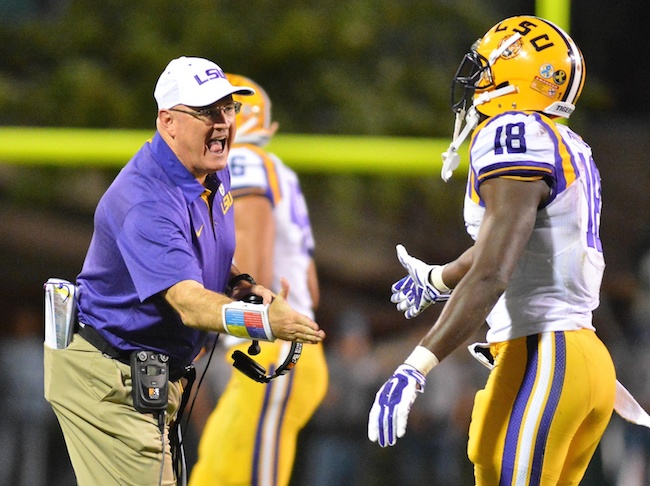
Back for senior year, Tre'Davious White hopes to get his nickel's worth
BATON ROUGE. La. — After LSU’s scrimmage on Tuesday, head coach Les Miles used the phrase “ball-hawking” to describe his secondary.
That, from a historical perspective, sounds right. After all, this is the defense that produced the Honey Badger, Tyrann Mathieu, a turnover-creating machine. And, as the defense that goes by the moniker “DBU,” you’d think that creating turnovers is part of the MO.
Only it wasn’t last season. But Tre’Davious White is part of the solution to change it this year.
LSU intercepted just 10 passes last season and only created 17 turnovers, only about 1.5 per game. Part of it, White says, was about scheme.
“I feel like we did pretty good,” White said. “We didn’t get as many turnovers because we played so much press coverage. We just turned around with our heads turned away from the ball. I think we will get more hands on the ball this year.”
The difference now? A new defensive coordinator with a different approach.
Under 2015 defensive coordinator Kevin Steele, now the defensive coordinator at Auburn, LSU ran a 4-3 front that relied on tight outside coverage and pressure from the defensive line. Under new defensive coordinator Dave Aranda, the Tigers will not only have a new base defense — a 3-4 look — but the Tigers will also apparently take a different approach, sitting back more and allowing players like White to react to the ball more than just stay with a receiver.
As for White, he’ll take on a new role, remaining a starter at cornerback but moving to nickel back when the Tigers chose to bring in a fifth defender. Donte Jackson will move into the third cornerback spot on the outside and White will move inside.
It might seem a little bit against the norm — isn’t it the “backup” defensive back that usually takes on that responsibility to match up with an opponent’s third receiver? — but it really makes sense.
With the slot receiver able to break to the inside or outside with plenty of field to work with (outside receivers are restricted by the boundary), inside receivers can be a tough cover for inexperienced or otherwise inferior nickel backs. And offenses aren’t afraid of putting their top-tier receivers in the slot, leaving nickels covering more talented receivers with more field to cover.
So it makes sense for an accomplished senior like White to be handed that responsibility.
“It’s just me having a few more years than those guys under my belt,” he said. “Just knowing what I’m going to get (from offenses), (defensive backs) coach (Corey) Raymond felt it was me.”
White has been around long enough to know the role. A three-year starter and Second-Team All-SEC pick last season, White would have likely been an NFL Draft pick had he opted to leave school after 2015. Instead, he decided to stick around and help the Tigers perhaps get over a hump they haven’t gotten over since the 2011 team won the SEC and played for the national championship.
He never played the nickel role until the Texas Bowl, when he was put into that spot for the Tigers’ 56-27 win over Texas Tech.
One better get used to seeing White in that role now. With all the spread offenses in college football, it’s more likely that LSU will play a large number of snaps with a fifth defensive back in the game to match up with multiple receivers.
Remember 2011, when Mathieu started at cornerback but did so much of his damage from the nickel position? That’s a role White now has.
He has embraced the coverage responsibilities from that spot — “You just have to believe in your break and believe in your leverage and stay on your leverage and drive to the football,” he said — and added that he’s ready to do more.
“It shows my versatility to go inside and out,” he said. “It’s basically the same thing (Mathieu did). We have a lot more space (to cover). I’ll be rushing off the edge, too. You’ll see.”
Put in a role similar to the Honey Badger, can White create similar plays? If so, it will have been something worth returning to school for.
